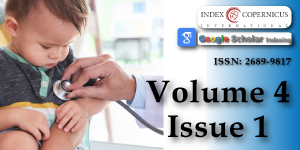A rare cause of neonatal diarrhoea: Microvillositary inclusion disease: about a case report
Main Article Content
Abstract
Microvillositary inclusion disease also known as microvillositary atrophy is a rare congenital enteropathy containing a border abnormality in the brushes of enterocytes, manifesting as severe rebellious diarrhea in newborns and infants. It was first described in 1978 by Davidson, et al. The autosomal recessive mode of transmission is suggested because of the frequency of familial cases and inbreeding. Histopathology plays an essential role in establishing the diagnosis. In 2008, a common mutation was identified in most of the patients studied in the MYO5B gene that codes for the Myosin Vb protein, which helped in understanding the etiopathogeny of this pathology poorly described in the literature. The prognosis for this pathology is extremely bleak, requiring total parenteral nutrition for child survival. Intestinal transplantation is for the moment the only long-term solution.
Materials and methods: We report the case of an infant aged 6 months, with no perinatal antecedent. There is 1st degree consanguinity, the mother has a history of deaths in younger siblings in undetermined circumstances. Who since the age of 3 days presents profuse liquid diarrhoea with malnutrition, dehydration and enormous abdominal distension? Several diagnoses were suspected before the jejune biopsy was carried out, which led to the diagnosis of a microvilliositary inclusion disease.
The aim of our work is to highlight the rarest cause of neonatal rebel diarrhoea and to know how to include it among other differential diagnoses.
Article Details
Copyright (c) 2021 Akhrif M, et al.

This work is licensed under a Creative Commons Attribution 4.0 International License.
Schoen K, Puchi A, González I, Torres MT, Espinosa R, et al. Enfermedad por inclusión microvellositaria como causa de diarrea congénita severa. Caso clínico [Microvillous inclusion disease as a cause of severe congenital diarrhea. Case report]. Rev Chil Pediatr. 2017; 88: 662-667.
Phulware RH, Gahlot GPS, Malik R, Gupta SD, Das P. Microvillous Inclusion Disease as a Cause of Protracted Diarrhea. Indian J Pediatr. 2019; 86: 854-856. PubMed: https://pubmed.ncbi.nlm.nih.gov/31049800/
Mahjoub F, Niknejad S, Sadeghian M, Abdirad A. Congenital microvillous atrophy, report of two consecutive siblings with complete histologic, immunohistochemical and detailed electron microscopic studies, first report from Iran. Open J Pathol. 2014; 4: 64–67.
Guellouz N, Zekri S, Youssef A, Zghald D, Ben Hariz M, et al. Maladie des inclusions microvillositaires à manifestation anténatale : à propos de trois observations familiales. J de Pédiatrie et de Puériculture. 2011; 24: 72-76.
Khubchandani SR, Vohra P, Chitale AR, Sidana P. Microvillous inclusion disease--an ultrastructural diagnosis: with a review of the literature. Ultrastruct Pathol. 2011; 35: 87-91.
Oktavia Sari Y, Bahari MB, Ibrahim B. Clinical review of total parenteral nutrition use among pediatric: Critics and outcomes. Int J Pharm Life Sci. 2013; 4.
Canani RB, Terrin G: Recent progress in congenital diarrheal disorders. Curr Gastroenterol Rep. 2011; 13: 257–264. PubMed: https://pubmed.ncbi.nlm.nih.gov/21494839/
Thiagarajah JR, Kamin DS, Acra S, Goldsmith JD, Roland JT, et al. Advances in Evaluation of Chronic Diarrhea in Infants. Gastroenterology. 2018; 154: 2045-2059.e6. PubMed: https://pubmed.ncbi.nlm.nih.gov/29654747/
Iancu TC, Manov I. Ultrastructural aspects of enterocyte defects in infancy and childhood. Ultrastruct Pathol. 2010; 34: 117–125. PubMed: https://pubmed.ncbi.nlm.nih.gov/20455660/
Phillips AD, Szafransky M, Man LY, Wall W. Periodic Acid Schiff Staining Abnormality in Microvillous Atrophy: Photometric and Ultrastructural Studies. J Pediatr Gastroenterol Nutr. 2000; 30: 34-42. PubMed: https://pubmed.ncbi.nlm.nih.gov/10630437/
Khubchandani SR, Vohra P, Chitale AR, Sidana P. Microvillus inclusion disease-An Ultrastructural Diagnosis: with a Review of the literatura. Ultrastruct Pathol. 2011; 35: 87-91. PubMed: https://pubmed.ncbi.nlm.nih.gov/21299349/
Jayawardena D, Alrefai WA, Dudeja PK, Gill RK. Recent advances in understanding and managing malabsorption: focus on microvillus inclusion disease. F1000Res. 2019; 8: F1000. PubMed: https://pubmed.ncbi.nlm.nih.gov/31824659/
Volonaki E, Sebire N, Borrelli O, Lindley KJ, Elawad M, et al. Gastrointestinal Endoscopy and Mucosal Biopsy in the First Year of Life: Indications and Outcome. J Pediatr Gastroenterol Nutr. 2012; 55: 62-65. PubMed: https://pubmed.ncbi.nlm.nih.gov/22210413/
Golachowska MR, van Dael CM, Keuning H, Karrenbeld A, Hoekstra D, et al. MYO5B mutations in patients with microvillus inclusion disease presenting with transient renal Fanconi syndrome. J Pediatr Gastroenterol Nutr. 2012; 54: 491–498. PubMed: https://pubmed.ncbi.nlm.nih.gov/22441677/
Bulut O, Ahishali B, Gulluoglu M, Arslanoglu S. A Case Study of Intractable Diarrhea Due to Neonatal Microvillous Inclusion Disease, Fetal Pediatr Pathol. 2017; 36: 340-343. PubMed: https://pubmed.ncbi.nlm.nih.gov/28707991/

